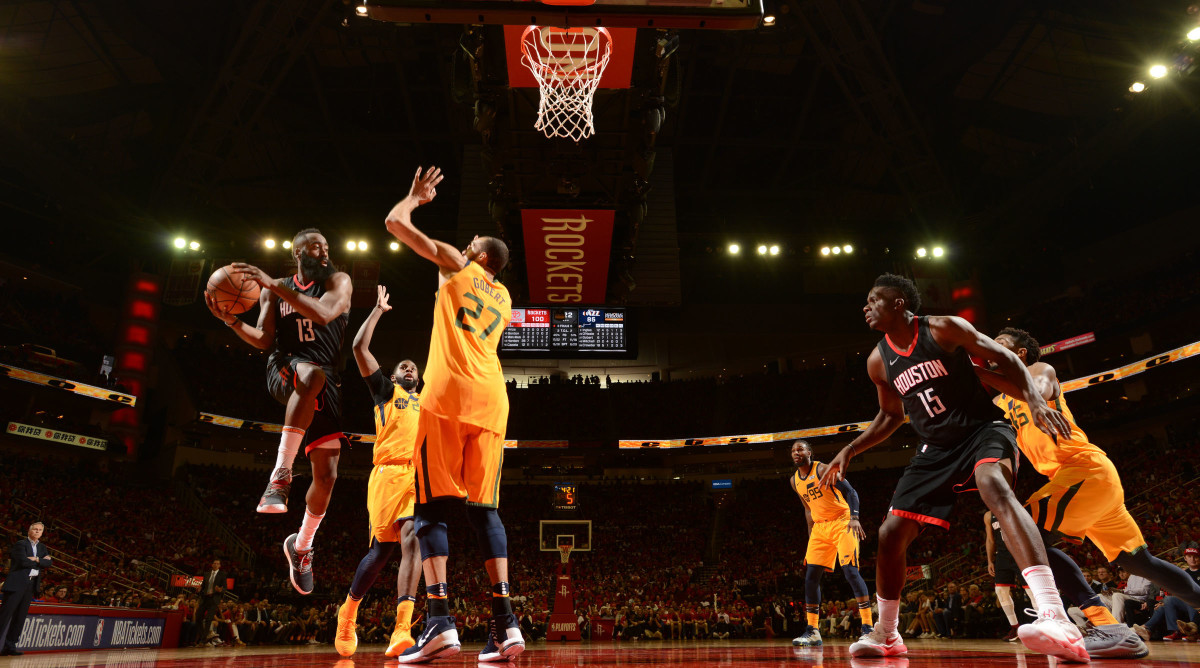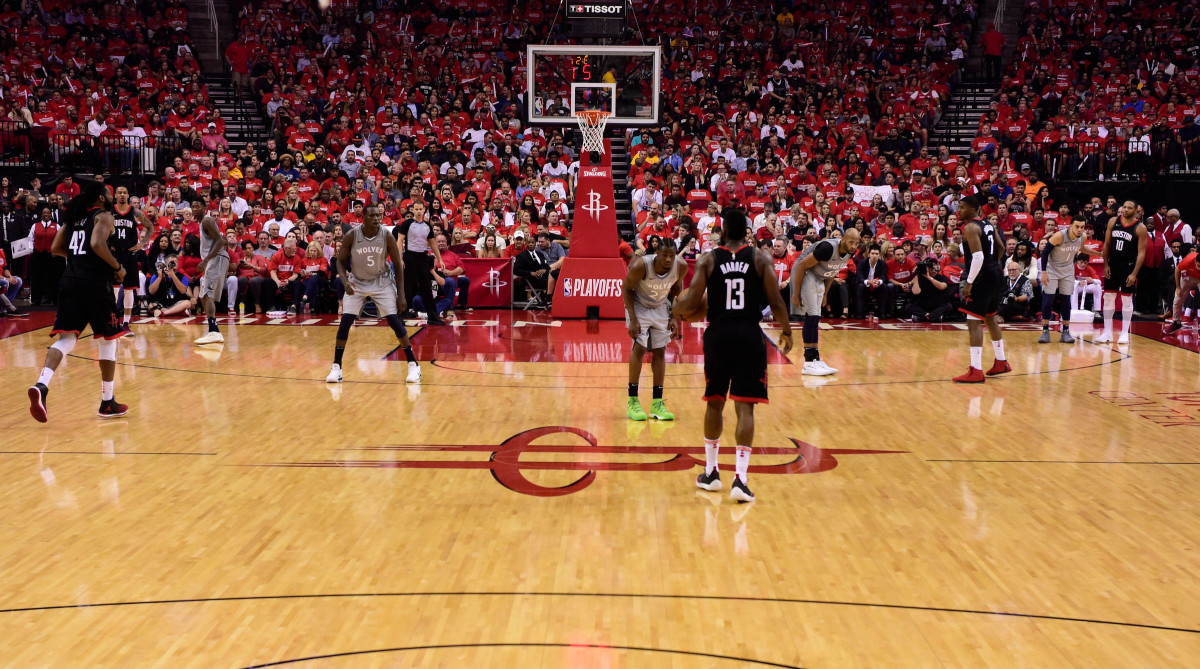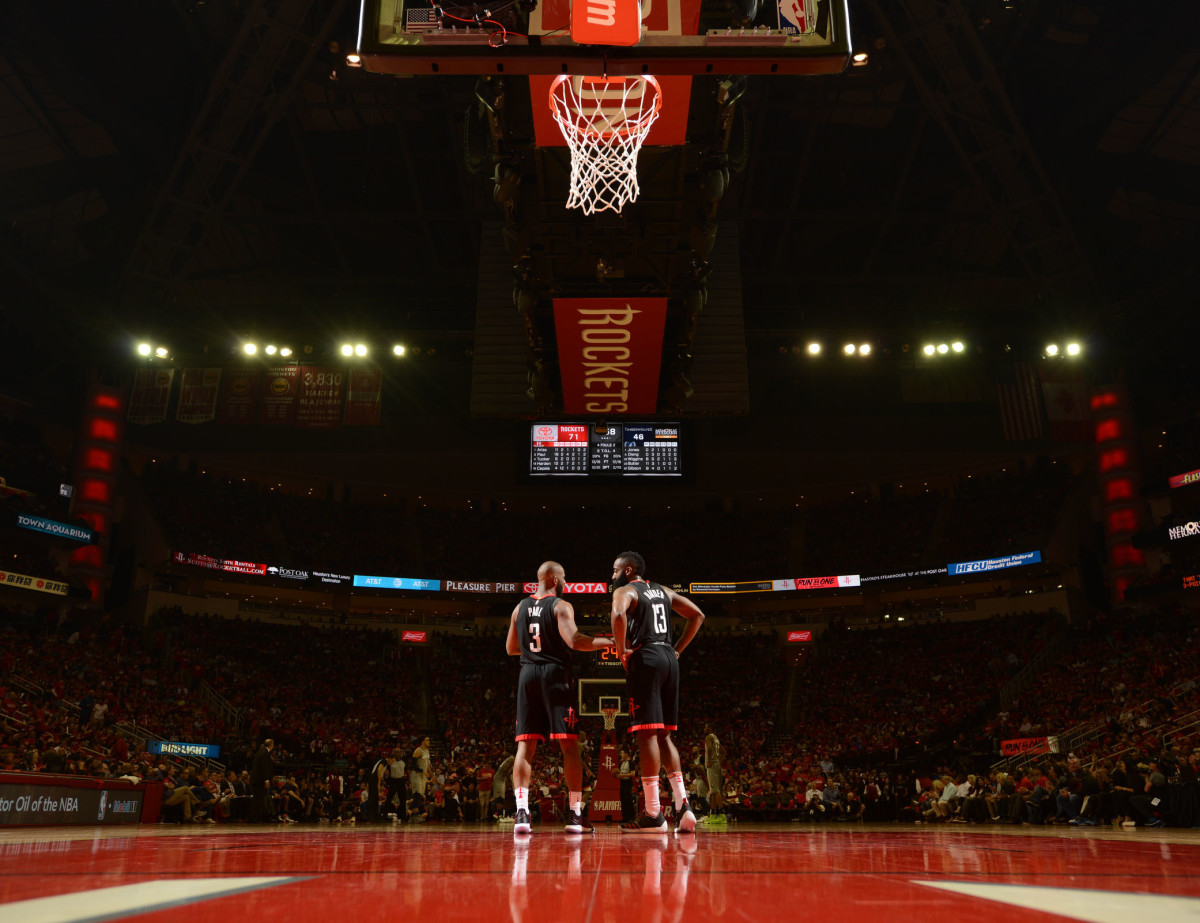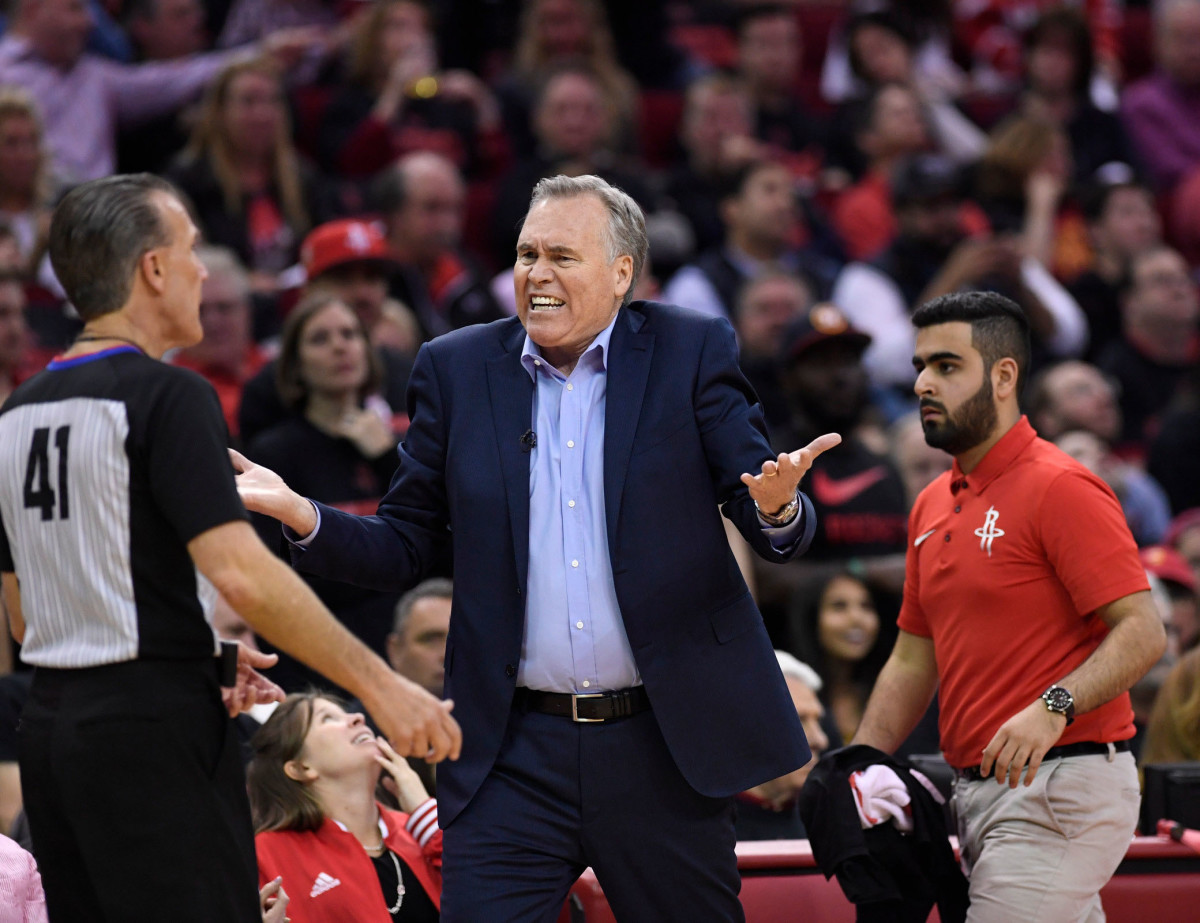Space City: How Faith Fuels the Rockets' Explosive Offense

Mike D’Antoni, offensive orchestrator, three-point proselytizer, pace-and-space pioneer, arrived in Milan in the summer of 1977 as a defensive specialist who could not score. He’d been a productive point guard in his first two seasons at Marshall, averaging more than 15 points on better than 45% shooting. Head coach Carl Tacy trusted D’Antoni, and in turn, D’Antoni trusted himself. But Tacy bailed for Wake Forest before D’Antoni’s senior year and uncertainty bred anxiety. “The old guy knew me,” D’Antoni says. “The new guy didn’t.” His shot faltered and his numbers dipped, but the Kansas City–Omaha Kings still picked him in the second round of the ’73 NBA draft, pegging him as a backup to Tiny Archibald. In ’74–75, D’Antoni put up fewer than three shots per game, afraid to let fly. “It was the yips,” he recalls. “I choked, more or less. I got to a point where I could barely make a layup. I shot fine in the summer, but I wasn’t mentally strong enough to do it in the winter. I didn’t believe in myself.”
He was an offensive liability, doubt-riddled and injury-prone. By the time the Spurs waived him in 1976 after two games, he’d reinvented himself as a stopper. “I was just a feisty little prick,” D’Antoni recalls, a disco-era Patrick Beverley. Nobody in the NBA wanted him, so he signed with Olimpia Milano, where he became famous for picking fights with opposing guards. He was ready to quit in ’78 and haul his broken shot home to West Virginia, when Olimpia hired a head coach from Chicago’s North Shore named Dan Peterson, who recognized that D’Antoni’s problem was not his stroke. It was his psyche. “You’re my point guard,” Peterson assured him. “No matter what, I’m never going to take you out, and if we lose, it’s not your fault. It’s mine.”
Peterson challenged D’Antoni to hoist at least 12 shots per game, regardless of how many he made. “If you go 2 for 19, I won’t say a word,” the coach vowed. “If you go 1 for 11, we’re going to talk, because you didn’t take 12.” Peterson cured D’Antoni’s yips by changing his perspective. Think about taking, not making. Peterson called constant pick-and-rolls, forming the letter L with his thumb and index finger, forcing D’Antoni to launch as defenders slipped under screens. When FIBA installed the three-point line in 1984, Peterson adopted the Lakers’ fast-break offense, with D’Antoni duplicating the roles of both Magic Johnson and Byron Scott. “If you come up to the three-point line on the break and you are open, you fire,” Peterson said. “I don’t care about rebounders.” When reporters questioned if D’Antoni was logging too many high-octane minutes, Peterson told them, “If he dies on the floor, he dies on the floor. He’s still never coming out.”
Over 13 seasons in Milan, D’Antoni won five Italian championships, two European titles and scored more than 5,500 points. He yearned to return to the NBA, but he worried that if his homecoming failed he would not be allowed back at Olimpia because of FIBA rules, which discouraged players from going back and forth. So he stayed. Someday, he’d show America what he learned overseas, that confidence is the most potent performance-enhancer of all. Someday he’d imbue others with the belief Peterson breathed into him, only he had no idea when or where.
The last player in the home locker room at Toyota Center is Gerald Green, rocking a navy Yao Ming throwback jersey after a Game 1 first-round victory over the Timberwolves. The Rockets signed Green in December, when he was unemployed in Houston and only playing in his driveway with his six dogs. D’Antoni summoned Green late in the fourth quarter at Dallas and after he clanked two shots, his head sunk. “When you miss your hundredth, I’m taking you out,” D’Antoni told him. “So you’ve got 97 misses to go.” A Houston native who has bounced around eight organizations in 12 seasons, Green became a revelation for the Rockets, averaging 12.1 points per game. But he scored just four points in the opener against Minnesota, and D’Antoni waited for him to dress. “You good?” the coach asked. “Lot better than being on the couch,” Green cracked. D’Antoni patted Green’s back. He joked about using the 6'7" swingman at center.
“You know how your girl always says, ‘You don’t ever tell me you love me!’ ” Green said later. “And you say, ‘Baby, you know I love you!’ And she says, ‘Yeah, well, I need to hear it sometimes!’ Basketball players are the same way. We need to hear it sometimes.”

In Game 2, Green swapped Yao’s jersey for a Warren Moon Oilers model, braided his hair into a Rockets logo, scored 21 points and dapped up owner Tilman Fertitta in the front row afterward. “So many places I’ve been, if you go left, that’s wrong, if you go right, that’s wrong,” Green says. “Here, there’s no wrong.” The top seed in the West, Houston dispatched the Wolves in five games, then took a 1–0 lead over the Jazz on Sunday in the second round. An MVP for guard James Harden and a conference finals showdown against the Warriors appear inevitable. The Rockets obviously cannot match wattage with Golden State, but they can hope Harden’s emboldened sidekicks narrow the gap. “All these guys have talent,” D’Antoni says. “All of them kicked ass somewhere. It’s a matter of unlocking them psychologically. You put pressure on them, they could go wild. You show faith in them. . . .”
They might really go crazy. Houston won 65 games this season, most in the NBA, on the strength of an offense that confounds with its simplicity. The Rockets pass and move less than any team in the league, according to tracking data. About 90% of the time, they run some variation of the same play (a pick-and-roll on one side of the court, two shooters perched behind the three-point line on the other) with the same people (Harden or Chris Paul handling the ball, Clint Capela setting the screen, everybody else spacing the floor). “I like when there’s no thinking,” says D’Antoni, still playing the bumpkin, unconvincingly as ever. “So we just do the same thing every frigging time.” His minimalist approach reminds general manager Daryl Morey of an Albert Einstein quote: “Everything should be made as simple as possible, but not simpler.”
D’Antoni’s favorite stat is OER—Offensive Efficiency Rating, measured in approximate points per 100 possessions—which he commits to memory because, of course, he likes when there’s no thinking. Houston leads the NBA in overall OER (116.1), half-court OER (112.8) and isolation OER (121.8), ranking second in transition OER (128.5) and pick-and-roll OER (113.5), per in-house research. All due respect to Green, some actions are wrong: namely, curls, pin-downs and any other stilted sets that produce midrange jumpers, with OERs under 100. “Why set something up to get the worst shot in basketball?” D’Antoni asks. When young centers wonder whether they should post up, player development coach Irv Roland politely explains why that’s an awful idea.
2018 Western Conference Playoffs: Second Round Preview
The Rockets’ preoccupation with threes, layups and nothing else has grown from curious to cultish, as they keep breaking their own NBA record for made treys. In film sessions trespassers who venture inside the arc to barf up a midrange J will get a red X superimposed on their face. “I was falling down!” former Houston guard Lou Williams protested last season. “I had to do it!”
Defenses know what’s coming, yet can’t stop it. In March the Spurs grew so desperate they dusted off a triangle-and-two, sending Rockets scurrying to the bench like kindergartners confronted with their first zone. “I haven’t seen a triangle-and-two since high school!” Paul says. “Davie County put it on me. J, you see a triangle-and-two since high school?” Harden strokes his philosopher’s beard. “Not even high school,” he replies. “Maybe AAU.”
A decade after the death of Seven Seconds or Less, D’Antoni is overseeing another offensive phenomenon, devastating in its deliberation. Harden and Paul don’t crisscross the court like Steve Nash. Forwards Trevor Ariza and Ryan Anderson don’t cut like Shawn Marion. Capela is a closer facsimile of Amar’e Stoudemire, but the larger point remains: The D’Antoni System is an evolving organism, shifting with the principals and the times. In one respect, the Rockets embody modern hoop wisdom, running 70 pick-and-rolls per game, jacking 40 threes, stationing marksmen 30 feet from the hole. In another, they are as vintage as Green’s wardrobe. “He’s an iso guy now,” says D’Antoni’s wife, Laurel. “I hate iso.”
Phoenix won with speed, Houston with space, vast expanses of hardwood where Hall of Fame guards can probe and kick. Extra passes and off-ball cuts may please the eye, but they can also clog lanes and cloud looks. “You move around a lot, you wind up closer to the rim, shooting runners and s---,” D’Antoni says. That’s how you earn an X in the face. Of course there are links between these Rockets and those Suns, more spiritual than strategic. Players have embraced niche roles, enjoyed career years and found freedom to let fly. “We’ll be in a timeout and guys will ask, ‘What if we do this,’ and he’ll say, ‘O.K., good, let’s do that,’ ” says forward P.J. Tucker. “Nothing he does is in ink. It’s all in pencil.”

Life in Space City seems pleasant. You can sleep in, because there are no morning shootarounds, and stay out, because someone is always planning dinner or bowling. You don’t have to pass, but you do get to shoot, and even if you miss 97 times, you can propose plays. Practices are 90 minutes, but don’t worry, you probably won’t have to deal with some manic rookie picking you up full-court. “I’ll tell that guy to back off,” D’Antoni says. “I want Chris and James to dominate, so they feel good. I don’t want anybody putting doubt in their mind.”
The morning before the playoffs, Paul strolled into D’Antoni’s office with a plate of pancakes and plopped down at his oval wooden conference table. The 66-year-old coach was working on his USA Today crossword puzzle (“I gotta build my confidence, too; The New York Times would just tear it down”) and listening to the Doors on his playlist. “I signed the papers for my house yesterday,” Paul announced. D’Antoni put aside the crossword: “If you need money. . . .”
The Rockets considered hiring D’Antoni in 2007, but he was employed by the Suns then, and again in ’11, when he was with the Knicks. After the job reopened in the summer of ’16, they discussed two types of candidates: an emergent coach who could stay for decades or an experienced one who could make the most of Harden’s prime. Back then Houston’s locker room was divided along the fault line separating Harden and Dwight Howard, and factions were so pronounced that one veteran told a new acquisition, “When you come here, you have to pick your side.” The Rockets tabbed D’Antoni to overhaul their offense as well as their atmosphere, and when free agency dawned in July, he was on the plane with team brass.
Their first stop was in Atlanta, for meetings with Al Horford and Kent Bazemore, but they could not secure commitments from either. They flew the next day to Los Angeles, where they pitched Eric Gordon. “You might lead the league in three-point attempts,” D’Antoni said. “You will never have more opportunities than you do with us.” Gordon was intrigued, but the sides were stuck over $3 million. “How much is he going to help?” Houston officials asked D’Antoni during a break in negotiations. D’Antoni knew Gordon from USA Basketball, had seen him spread the floor but also handle the ball, and sensed he was selfless enough to accept a sixth man role. “He’s going to help a lot,” D’Antoni said. The Rockets met Gordon’s price, $53 million over four years.

They drove straight to Anderson’s house in Newport Beach, where D’Antoni gave the same spiel to another sniper, on a deck overlooking the Pacific. A Sacramento native, Anderson held a richer offer from the Kings, and he was torn between the comfort of home and the lure of contention. When the Rockets’ contingent left, they were convinced Anderson would rain his threes in Sac. Six hours later, just before their plane took off for Houston, he called to take the deal. The terms were high—another four years, $80 million—but Space City was born.
D’Antoni created “teaching tapes” with footage from his time with the Suns and the Knicks (“I didn’t do much coaching after that,” he says of his two-year stint with the Lakers), illustrating the importance of quick outlets, choreographed breaks and sledgehammer screens. Everybody runs a lane, taking the widest path to preserve room for the point guard. Even the five man, unless he can beat the field downcourt, stays out of the middle. “Who the f--- am I?” Stoudemire used to ask. “Carl Lewis?”
D’Antoni lionizes his ballhandlers, and as Stoudemire would attest, abuses his big men. “This is what you’re going to do for us,” D’Antoni told Capela in their first training camp. “Protect the rim, run the floor, set a pick, roll to the basket—oh, it didn’t work—go back, set another pick and do it over again. I’m going to yell at you, but if we win a championship, you’ll be the reason, and if we lose, it’s not your fault. We’ll still probably give you $80 million.” Capela, then a part-time starter, has seen most of D’Antoni’s prophesies come true. While Gordon is the reigning Sixth Man of the Year, Capela is the league’s most prolific roller, and he will hit restricted free agency this summer.
Summer of Showtime: Why All Eyes Will Be on the Lakers
Behind the blockbuster contracts, 40-point quarters and moonbeam threes, there is drudgery to what the Rockets do. Some players are worked to exhaustion, others bored to tears. Houston regularly positions three shooters in fixed locations behind the arc and essentially tells them to stay out of the way. They are vital bystanders. If they weren’t so accurate, or so committed, defenders could leave them for Harden and shrink the precious space. “There are times I feel like I’m not having a huge impact on a game,” Anderson says. “But we were all brought here for a reason.”
The Rockets present opponents with an impossible decision: Let Harden and Capela play two-on-one at the rim, or watch Anderson & Co. drop three-balls from the sky. A surprising number of teams take their chances with Harden and Capela. In March the Trail Blazers doubled on the perimeter and conceded a 48-minute layup line. But the moment Anderson starts to wonder, in D’Antoni’s words, “Why the f--- am I just standing here?" his man inevitably cheats a step and Harden hits him with a crosscourt heater. "I know it’s tough not to touch the ball,” D’Antoni tells his spacers at timeouts. “But keep running to the corner.”
He carries a folded white pamphlet filled with plays he calls for Anderson, Ariza, Tucker and Gordon, to keep their eyes from glazing over. “I kiss their ass all day,” he laughs. Film sessions turn into testimonials. P.J., you sprinted to the right corner, and because of that James got a layup. Trevor, you ran five times in a row to the left corner and got a three on the sixth one. Ryan, you got Clint that dunk. Before every game the Rockets show a different three-minute highlight video in their locker room, Harden’s hypnotic dribbling exhibitions spliced with Nenê’s brutal screens.
No team has more stars than the Warriors. But no team does more to amplify its stars than the Rockets.

Joe Johnson arrived in February off the buyout market, reuniting D’Antoni with a former player who didn’t love sprinting to that corner in Phoenix but did it anyway and wound up nabbing $70 million from the Hawks. Johnson’s presence should inspire nostalgia in D’Antoni, but it does the opposite. The sight of 36-year-old Silent Joe transports him to 2005, when Johnson broke his left orbital bone in the playoffs, and a 62‑win season was lost. Johnson decamped for Atlanta that summer, and at the time the Suns did not recognize the significance. They won 54‑plus games in each of the next three seasons but never reached the Finals, and D’Antoni still ponders why.
“Joe was able to handle the ball, but when he wasn’t there, Nash had to run everything,” D’Antoni says. “It wore him down.” He grins through gritted teeth. “Goddam Joe.” In Game 6 of last year’s conference semis, D’Antoni suffered Phoenix flashbacks, as Harden went 2 for 11 in a 39-point rout by the Spurs. Much was made of Harden’s clunker, but when club officials reviewed playoff video, they noticed signs he was fried even in the first round. By adding Paul, the Rockets corrected the Suns’ mistake, allowing an otherworldly but overworked ballhandler to steal breathers and eliminate listless possessions. They also unleashed D’Antoni, who had deployed a more traditional offense with Harden on the bench, to run his beloved pick-and-roll even more often. “Let’s turn it up another notch,” he told his staff last summer. “Every frigging time.”

D’Antoni clashed with Kobe Bryant in L.A. and Carmelo Anthony in New York, but he has become an unlikely superstar whisperer in Houston. The difference may be that Bryant and Anthony were wings, while Paul and Harden are point guards. Or perhaps he is catching them at a better time in their careers and a better time in history. “I don’t know,” Paul says. “But I do know I want to win this for him.” D’Antoni insists he does not crave the validation that stems from a title, and he will be happy playing corn hole back home at the Greenbrier no matter how the spring unfolds, but his wife sounds less certain. “No, he’s not at peace,” Laurel says. “That’s what he misses and that’s what he wants.”
Like Paul, D’Antoni is affixed with an easy label, regular-season visionary and postseason patsy. The pace typically stalls in the playoffs, as coaches call more sets, and the slowdown may have gummed up the Suns. The Rockets are more suited to a reduced tempo, but during a meeting with lead offensive assistant Brett Gunning before the Minnesota series, D’Antoni stresses speed. On the greaseboard in his office, he writes the four quadrants of the shot clock: 0–6 seconds, 6–12, 12–18, 18–24. “If we live in the first two quadrants, our OER is 130,” D’Antoni starts. “Defenses are scrambling, trying to figure out what we’re doing. We’ve drifted more toward these last two quadrants recently, and we don’t want to do that.”
Gunning queues up a clip on the office TV from a previous game against the Timberwolves, a Tucker three in the second quadrant, when Minnesota center Karl-Anthony Towns was late to contest. D’Antoni and Gunning have approximately 20 pet plays, but they don’t want to make Harden or Paul stop and look at the sideline, so they’re only able to use about 10. They dial them up at timeouts and quarter breaks, sometimes as diversion from standard pick-and-rolls, sometimes as camouflage. “We’ve got too much s---,” D’Antoni laments. “I can’t figure out what I’m doing.” Here he goes with the hayseed act again. They like their 50s series—Capela and a teammate setting a stacked screen, with the teammate popping out for three—and a play called Nash, which is not to be confused for Mash, where they throw a blob of red-and-white jerseys near the free throw line and break them out at random. The Rockets ran the blob against Phoenix in March, and as Suns forward Marquese Chriss hollered instructions, Green slipped to the corner for a buzzer-beating three. “Now show Toronto,” D’Antoni says, and Gunning queues up another blob, Raptors guard Kyle Lowry gesticulating wildly as Gordon drills a 30-foot three.
“They have no idea what’s coming,” Gunning says, “because neither do we.”
“Yeah,” D’Antoni replies. “But when we screw this up and lose a playoff game, it will be, ‘These guys are just messing around! They don’t know what they’re doing!’ ”
Gunning brings the coach back to his comfort food, a Harden/Capela pick-and-roll in Minnesota, with Gordon on the right wing, Ariza on the left and Luc Richard Mbah a Moute tucked into the left corner. “Stop!” D’Antoni chirps, and Gunning pushes pause. “We might disguise this a thousand different ways but 90% of what we do is right here,” D’Antoni says. “I believe, of all the things in basketball, with the guys we have, you cannot guard this in a traditional way. It’s not possible.”
D’Antoni leans back in his chair at the head of the oval table. He sips his Diet Coke. “Too Late to Turn Back Now” comes on the stereo. Gunning presses play. By the time Harden takes the handoff from Capela at the top of the circle, he has a step on Andrew Wiggins, who is in pursuit. But the T-Wolves’ helpers can’t leave the Rockets shooters. As Harden drives left down the lane, Capela rolls, and Towns has to pick up one of them. There is no good choice. He takes Capela. Harden lays the ball off the glass and in.
